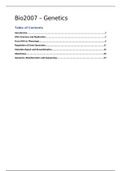Bio2007 – Genetics
Table of Contents
Introduction.......................................................................................................................2
DNA Structure and Replication...........................................................................................2
From DNA to Phenotype.....................................................................................................6
Regulation of Gene Expression.........................................................................................11
Mutation Repair and Recombination................................................................................16
Inheritance.......................................................................................................................20
Genomics, Bioinformatics and Sequencing.......................................................................23
,Introduction
Genetics: seeks to understand the rules that govern the transmission of genetic information
(inheritance) at three levels.
Transmission genetics: from parent to offspring within families
Molecular developmental genetics: from DNA to gene action within and between
cells.
Population-evolutionary genetics: over many generations within populations of
organisms.
For reproduction and development, different cells are required.
Somatic cells: bodily cells, containing 2 copies of a particular gene
Gametes: sex cells, egg and sperm, containing only 1 copy of a particular gene
All our cells contain chromosomes, with DNA on which genes are located.
Genes: encode enzymes that perform metabolic functions within cells. They are
regulated by turning them on and off, thereby controlling gene expression. Of each
gene, different variants exist, known as alleles.
o Dominant
o Recessive
The molecular structure of DNA is in the form of a double helix, with two strands of DNA
wound side-by-side in a spiral. The backbone of each strand is made of sugar and phosphate
groups. Connections between the two strands are made by 4 bases, which are specifically
hydrogen bonded to each other depending on complementary shapes and charges. The
sequence of bases in DNA represents the coded information carried by the molecule.
Adenine (A) pairs with thymine (T) by a double hydrogen bond.
Guanine (G) pairs with cytosine (C) by a triple hydrogen bond.
There are different types of information transfer among biological molecules:
DNA replication: the process by which a copy of DNA is produced. Enables each of
the two daughter cells that result from cell division to have a complete copy of all
the DNA of the parent cell.
Transcription: Ribonucleic acid (RNA) synthesis from a DNA template. mRNA serves
as a template for protein synthesis.
Translation: protein synthesis by translating information from mRNA (codons) into
the sequence of amino acids that compose a protein. This happens in ribosomes in
the cytoplasm of the cell. Proteins serve as enzymes, structural components of the
cell, and molecules for cell signaling.
(transformation): to add (foreign) genes from one species into the genome of
another. The roganism then becomes a genetically modified organism (GMO)
DNA Structure and Replication
DNA is made of 3 basic building blocks/components, which are arranged into groups called
nucleotides.
Phosphate
, Deoxyribose: has a hydrogen atom, instead of a hydroxyl (OH) group at the 2’-
carbon atom when compared to ribose.
Nitrogen base: attached to the 1’ carbon of deoxyribose, a purine base always pairs
with a pyrimidine base (T=A, C≡G) through hydrogen bonding. A double stranded
DNA strand will therefore always contain as many A as T and as many G as C
(Chargaff’s rule). DNA containing more C-G base pairs is more stable, since they pair
through 3 hydrogen bonds instead of 2.
o Purines: double ring structure
Adenine (A)
Guanine (G)
o Pyrimidines: single ring structure
Cytosine (C)
Thymine (T)
The double helix consists of two nucleotide strands held together by hydrogen bonds
between the bases of each strand. The backbone of each strand of formed of alternating
phosphate and deoxyribose sugar units connected by phosphodiester linkages. Each sugar
phosphate backbone has a 5’ to 3’ polarity/direction and they are located antiparallel to
each other, thereby creating a right-handed double helix. Furthermore, the structure has
two distinct sizes of grooves running in a spiral:
Major groove: outside, contains DNA-protein associations
Minor groove: inside
Replication: how parental DNA is possibly related to daughter molecules, in 3 alternative
methods.
Semiconservative: DNA unzips, and each exposed base will pair with its
complementary base. Each of the two strands will serve as a template to direct the
assembly of complimentary bases to reform a double helix identical with the original.
Conservative: the parent DNA molecule is conserved, and a
single daughter double helix is produced consisting of two
newly synthesized strands.
Dispersive: daughter molecules consist of strands each
containing segments of both parental DNA and newly
synthesized DNA.
The Meselson-Stahl experiment demonstrates that DNA is copied by
semiconservative replication. DNA centrifuged in a cesium chloride
(CsCl) gradient will form bands according to its density. When the cells
grown in 15N are transferred to a 14N medium, the first
generation produces a single intermediate DNA band and the second
generation produces two bands: one intermediate and one light. This
result matches the predictions of the semiconservative model of DNA
replication. The results predicted for conservative and dispersive
replication were not found.
During replication, a replication fork is formed in the DNA. This is the location at which the
double helix is unwound to produce the two single strands that serve as templates. DNA






